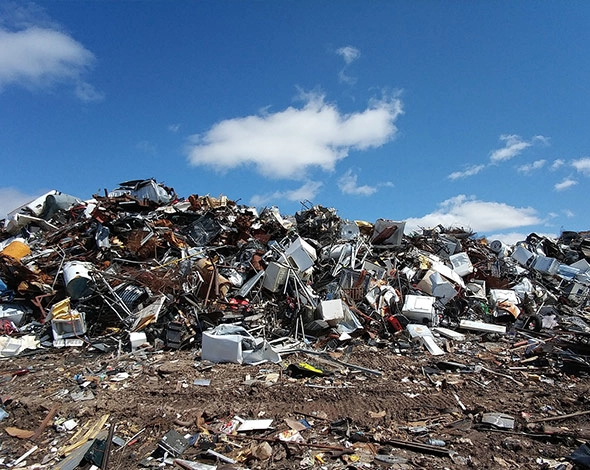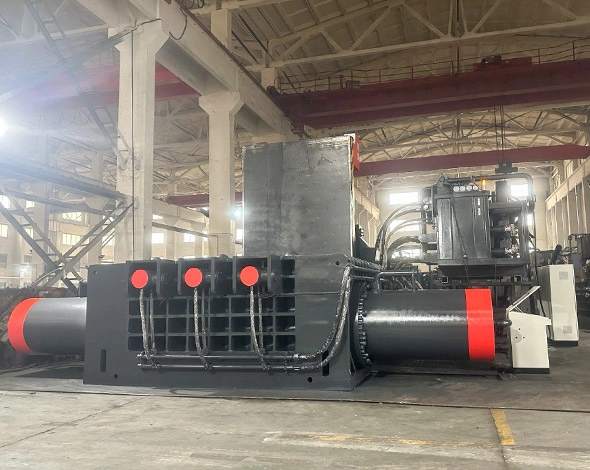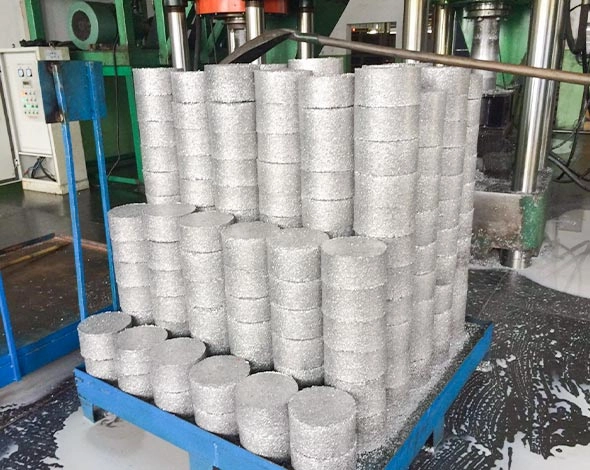Choosing a suitable metal recycling baler is essential for businesses looking to enhance their recycling efficiency and environmental sustainability. Metal balers compact scrap metal, reducing its volume for easier handling, transportation, and recycling. This helps save valuable space and significantly reduces the carbon footprint associated with metal waste.
This guide aims to simplify the selection process by highlighting key considerations such as baler types, size, and operational needs. Whether you’re dealing with large volumes of metal scrap or just a modest amount, understanding these basics will guide you toward making an informed decision that aligns with your business’s recycling requirements and sustainability objectives.
Understanding Metal Recycling Balers
Metal recycling balers are pivotal in the recycling industry, transforming bulky scrap metal into compact, manageable bales. These machines not only facilitate easier handling and transportation but also significantly enhance the efficiency of recycling operations.
Understanding the fundamentals of metal recycling balers is crucial for businesses investing in the right equipment to meet their recycling needs.
Definition and Purpose
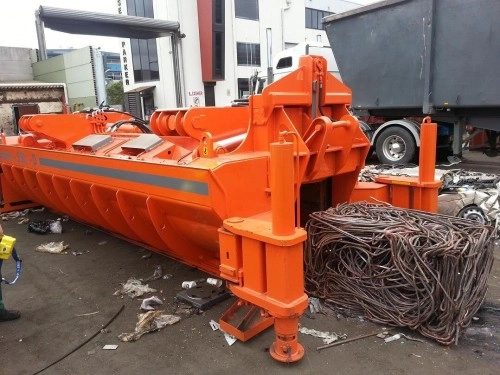
A metal recycling baler is a machine that compresses metal scraps into dense, square, or rectangular blocks. These bales are easier to handle, transport, and store, increasing recycling efficiency. Balers are essential in reducing the volume of scrap metal, which minimizes storage space and transportation costs.
Types of Metal Balers
There are several types of metal recycling balers, each designed to meet specific operational needs:
Vertical Balers: Vertical balers are best suited for small to medium-sized operations. They are operated manually and are excellent for compressing smaller volumes of metal scraps.
Horizontal Balers: These are more automated than vertical balers and can handle higher volumes of metal scrap. Horizontal balers are ideal for extensive recycling facilities that deal with various materials.
Two-Ram Balers: Designed for heavy-duty operations, two-ram balers offer high levels of automation and efficiency. They can process diverse materials and can handle large volumes of scrap metal without the need for pre-sorting.
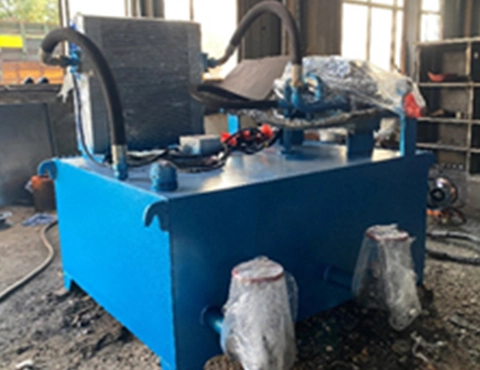
Understanding the different types of metal recycling balers and their capabilities is the first step in choosing the right equipment for your business. Whether your operation is small or large, there is a baler configuration out there that can meet your recycling needs, improve your operational efficiency, and contribute to your sustainability goals.
Assessing Your Needs
When considering the acquisition of a metal recycling baler for your business, a thorough assessment of your specific needs is critical. This evaluation will ensure that you select a baler that aligns with your operational requirements and guarantees efficiency and cost-effectiveness in the long run.
Here’s how to assess your needs accurately:
1. Volume of Material
Determining the volume of metal scrap your business generates is essential. This involves the quantity (how much metal waste you produce within a specific timeframe) and the frequency (how often you accumulate a significant amount of scrap). High-volume generators might benefit from a larger, more automated baler, while businesses with lower volumes might find a smaller, vertical baler more appropriate.
2. Types of Metals to be Baled
The variety of metals you need to process can also influence your choice of baler. Different metals have varying levels of flexibility and strength, which can affect the compression process. For instance, aluminum is more malleable than steel and may require less force to bale. Ensuring your baler can handle the specific types of metals you work with.
Additionally, consider the labor requirements for each of these steps. Some balers are more automated than others, reducing the need for manual labor but possibly requiring more skilled operators. The efficiency of your operation can significantly influence the type of baler you choose and how it’s integrated into your recycling processes.
3. Environmental Impact
Your environmental goals should also be considered when assessing your needs. Selecting a baler that reduces waste volume more efficiently can lower transportation emissions and the carbon footprint of your recycling operations. Furthermore, by choosing an energy-efficient baler, you contribute to a more sustainable business model, aligning with broader environmental objectives.
4. Budget Considerations
Budget is always a consideration. The cost of a baler machine includes the initial purchase price and long-term operating costs, including maintenance, repair, and energy consumption. It’s essential to calculate the total cost of ownership for the baler models you are considering to ensure they fit within your budget while also meeting your recycling needs.
5. Future Growth
Finally, consider your business’s future growth and how that might affect your recycling needs. Investing in a baler that can scale with your operations can prevent the need for a costly upgrade. If you anticipate significant growth in your metal scrap volume or diversity, look for a baler that can handle increased loads or a wider variety of materials.
By carefully evaluating these aspects, you can ensure that the metal recycling baler you choose is well-suited to your business’s specific needs, enhances your recycling efficiency, supports your environmental goals, and provides value for years.
Key Features to Look for in a Metal Recycling Baler
When selecting a metal recycling baler for your business, focusing on key features that align with your operational requirements, efficiency goals, and budget constraints is crucial. Here are essential features to consider:
Size and Load Capacity
Baler Size: Ensure the baler fits within the designated space in your facility without disrupting workflow. Consider both the footprint and height of the machine.
Load Capacity: Choose a baler that can handle the volume of scrap metal you produce. Assessing the load capacity is crucial for maintaining efficient operations without overburdening the machine.
Ease of Use and Maintenance
User-Friendly Interface: Look for balers with intuitive controls and clear instructions to minimize training time and reduce operator errors.
Maintenance Requirements: Consider balers designed for easy maintenance. Quick access to everyday maintenance points and the availability of replacement parts can reduce downtime and operational costs.
Safety Features
Safety Mechanisms: Essential for protecting operators, safety features include emergency stop buttons, automatic shut-off sensors, and protective guards. Ensure the baler complies with relevant safety standards.
Training and Support: Verify that the vendor offers comprehensive training on safe operation and maintenance and responsive support for any safety concerns.
Efficiency and Performance
Operational Speed: A baler’s cycle time—how long it takes to complete one baling process—can impact overall productivity. Faster cycle times can enhance efficiency, especially for high-volume operations.
Energy Efficiency: Balers that consume less power without compromising performance can significantly reduce long-term operational costs. Look for models with energy-saving features.
Versatility
Material Compatibility: If your business recycles various types of metals, consider a baler capable of handling different materials without significant adjustments.
Adjustable Bale Sizes: The ability to adjust bale sizes and weights can be beneficial for meeting specific transportation or processing requirements.
Durability and Reliability
Construction Quality: High-quality materials and construction can ensure the baler withstands the demands of heavy use and extends its service life.
Warranty and Service: A comprehensive warranty and accessible, reliable customer service from the manufacturer can provide peace of mind and protect your investment.
Cost of Ownership
Initial Purchase Price vs. Long-term Savings: While the upfront cost is a significant factor, consider the baler’s efficiency, maintenance costs, and potential savings on waste disposal and recycling.
Energy Consumption: Assess the energy requirements of the baler and how they align with your operational budget.
Choosing a metal recycling baler with these features can streamline your recycling process, enhance safety, and contribute to a more sustainable and profitable operation.
Cost Considerations
Understanding the full spectrum of cost considerations is essential when investing in a metal recycling baler. These costs include the initial purchase price, operational costs, maintenance costs, and potential long-term savings.
Here’s a breakdown of the critical cost considerations:
Initial Purchase Price
The upfront cost of a metal recycling baler can vary widely based on size, capacity, and features. While a higher initial investment might secure a more efficient or durable machine, it is essential to balance this with your budget and immediate needs.
Operating Costs
Energy Consumption: Balers require electricity to operate. Their energy efficiency directly influences your monthly utility bills.
Maintenance and Repairs: Regular maintenance is necessary to keep a baler in good working condition, which involves parts and labor costs. Unexpected repairs can also add significant expenses.
Consumables: Some balers need additional materials, such as wires or straps, to bundle the bales, which can increase the ongoing costs.
Training and Safety
Operator Training: Ensuring your staff is adequately trained to operate the baler safely and efficiently might require investing in training sessions, which could incur costs.
Safety Equipment: Depending on the operation, additional safety equipment may be necessary for operators.
Potential Savings
Reduced Waste Disposal Fees: By compacting scrap metal into bales, you can reduce the volume of waste, potentially lowering disposal fees or increasing the value of your recyclable materials.
Efficiency Gains: A more efficient baler can process materials faster and with less energy, saving labor and utility costs over time.
Resale Value
If you plan to upgrade or replace the baler, consider its potential resale value. High-quality balers that are well-maintained can retain a significant portion of their value.
Financing Options
Explore financing options to spread out the cost of the baler. Leasing equipment can also be a cost-effective solution for some businesses, offering the flexibility to upgrade without a large initial outlay.
Evaluating Total Cost of Ownership
Calculate the total cost of ownership (TCO), including all the abovementioned costs, to make an informed decision. A baler with a lower purchase price but higher operating costs might be more expensive in the long run compared to a more efficient, albeit initially costlier, option.
By carefully considering these cost factors, you can select a metal recycling baler that fits your budget and offers your business the best value and return on investment.
The Environmental Impact
Investing in a metal recycling baler is not just a business decision; it’s also an environmentally conscious choice. The environmental benefits of using a metal recycling baler are significant, touching on various sustainability and resource conservation aspects.
Reduction in Landfill Use
By compacting scrap metal into dense bales, balers significantly reduce the volume of waste. This reduction means less scrap metal ends up in landfills, conserving valuable land resources and minimizing the environmental damage associated with landfill use.
Conservation of Natural Resources
Recycling metals through baler machines can reduce the demand for new metal mining and thus protect natural resources. Recycling metals requires considerably less energy than producing metals from virgin ore, leading to substantial savings in energy consumption.
Energy Efficiency
Recycling metals with a baler is far more energy-efficient than extracting and processing virgin materials. Energy savings from recycling metals can be remarkably high, contributing to a reduction in greenhouse gas emissions. This efficiency helps conserve energy resources and plays a significant role in combating climate change.
Reduction in Carbon Footprint
The compacting and recycling of metals significantly reduce the carbon footprint associated with metal waste management. By lowering the volume of scrap metal, balers reduce the trips needed to transport materials to recycling facilities or landfills, thereby decreasing fuel consumption and emissions.
Prevention of Pollution
Metal recycling using balers helps prevent pollution from mining activities, including air and water pollution. Reducing energy consumption also decreases the pollution associated with energy production, such as emissions from power plants.
Promotion of Sustainable Practices
Adopting metal recycling balers encourages sustainable practices within the industry and among consumers. It sends a strong message about the importance of resource conservation and environmental responsibility, influencing others to consider the environmental impact of their actions.
Long-term Environmental Benefits
The cumulative effect of recycling metals using balers contributes to long-term environmental benefits. These include the preservation of ecosystems, the protection of wildlife habitats from the adverse impacts of mining, and the overall reduction of the industry’s ecological footprint.
Choosing a metal recycling baler is a step towards sustainable business practices. It aligns with global efforts to reduce waste and conserve resources and positions a business as an environmentally responsible entity in its community and industry.
Vendor Selection and Support
Selecting the right vendor for your metal recycling baler is as crucial as choosing it. The vendor supplies the equipment and provides essential support throughout the baler’s lifespan.
Here are vital factors to consider when selecting a vendor:
Reputation and Experience
Industry Standing: Look for vendors with a strong reputation in the industry. Reviews, testimonials, and case studies can offer insights into their reliability and the quality of their products.
Experience: Vendors with extensive experience supplying metal recycling balers will likely offer products tested and proven in various operational settings.
Product Range
Variety of Options: A vendor with a wide range of baler models can offer solutions that closely match your needs. This diversity ensures that you’re not limited to a one-size-fits-all approach.
Innovation: Choose a vendor that invests in research and development. Innovative features can improve efficiency, safety, and user experience.
After-Sales Support
Customer Service: Responsive and accessible customer service is vital. Ensure the vendor has a reputation for promptly addressing inquiries and issues.
Maintenance and Repair Services: Check if the vendor provides ongoing maintenance and repair services. Access to skilled technicians can minimize downtime and extend the life of your baler.
Parts Availability: A good vendor ensures that spare parts are readily available, preventing long waits for repairs and maintenance.
Training and Resources
Operator Training: Proper training is essential for safe and efficient baler operation. Vendors should offer comprehensive training programs for their staff.
Documentation: Look for vendors that provide detailed manuals and resources for troubleshooting and routine maintenance. This support is crucial for your baler’s day-to-day operation.
Warranty and Service Agreements
Warranty Terms: Understand the warranty terms and what they cover. A solid warranty can provide peace of mind and protect your investment.
Service Agreements: Consider vendors that offer service agreements or maintenance contracts. These agreements can ensure your baler operates optimally and may include regular check-ups and preventive maintenance.
Financial Options
Financing Solutions: Some vendors offer financing options or leasing agreements, which can make a metal recycling baler more accessible by spreading the cost over time.
Environmental and Safety Standards
Compliance: Ensure the vendor’s balers comply with relevant environmental and safety standards. Compliance with these standards is an indicator of quality and reliability.
Evaluating potential vendors based on these criteria can lead to a more informed decision, ensuring you select a partner to provide the best equipment and support for your metal recycling needs.
Conclusion
Selecting a suitable metal recycling baler is a strategic decision that enhances your operation’s efficiency and sustainability.
By carefully evaluating your business needs, prioritizing essential features, understanding cost implications, and choosing a reputable manufacturer, you can invest in a baler that meets your recycling goals and contributes to a more sustainable and profitable future.
This choice reflects a commitment to environmental responsibility and operational excellence.

